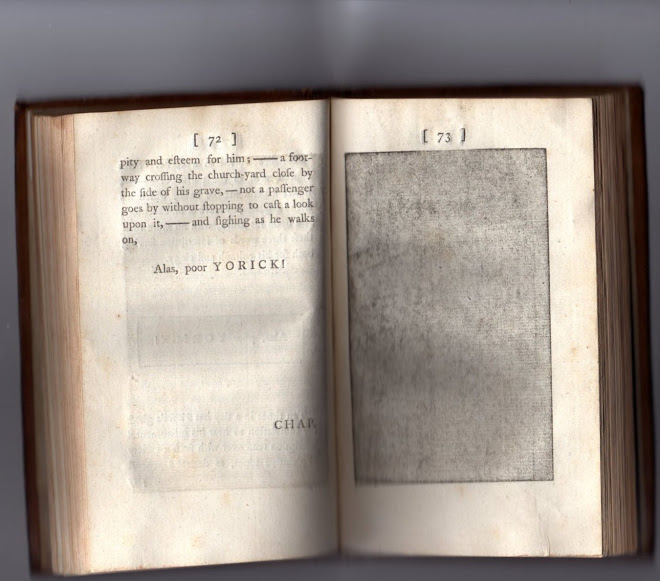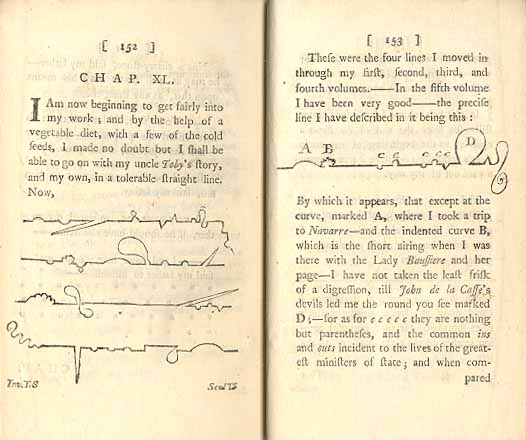- Start slowly at the beginning. We focused on the opening chapter for almost an entire day. We read the first two volumes together over two weeks.
- Take the time to enjoy the weird textual quirks in class--students love talking about the black page, the marbled page, the squiggly lined diagrams of narrative "progress," and the white page where the reader can draw his or her own ideal portrait of feminine beauty.
- Have the students branch out to read individual volumes on their own and then report their findings back to the class. This works especially well if you ask students to explain one particular digression that they find interesting, funny, or important. It works well in the classroom both because students came to class already excited about a particular textual passage and because the "plot" of Tristram Shandy really is in the digressions.
The opening sentence:
I wish either my father or my mother, or indeed both of them, as they were in duty both equally bound to it, had minded what they were about when they begot me.
- What is Tristram saying in this opening line?
- What are your reactions? What specific affect (emotion) did it produce in you?
- Why do you think Sterne starts here? It’s a weird beginning for an "autobiography," no?
The Black Page:
Another major topic of classroom discussion is the black page that follows the reported death of the parson Yorick, who dies from a broken heart because of a war of words; after he incurs the wrath of the townspeople for his indecorous bons mots, they attack him with slander until he gives up. After the following passage, the book is marked by a black page:
Ten times a day has Yorick's ghost the consolation to hear his monumental inscription read over with such a variety of plaintive tones, as denote a general pity and esteem for him;—a foot-way crossing the church-yard close by the side of his grave,—not a passenger goes by without stopping to cast a look upon it,—and sighing as he walks on, Alas, poor Yorick!
- What do you make of this? What are various things that this black page could signify?
Through browsing the website of the Laurence Sterne Trust, I found a wonderful site--The Black Page--that features modern artistic renderings of the famous black page in Sterne's book (all of the images below come from that site). These images act as interpretations of the black page, and they can help students to tease out possible meanings such as the following:
- The black page is a door or a portal; it can show someone either passing into a new place (the afterlife) or being shut out of a place (social acceptance).
- The black page is a black void (a sign of emptiness) or a overabundance of inky words (a sign of presence).
- The black page can be impersonal and abstract (a sign of the loss of identity), or it can be the thumbprint or signature mark of Tristram the narrator or Sterne the author (a sign of someone proclaiming his personality).
- The black page can be mournful (a sign of grief and/or sentimentality) or humorous (a playful moment of satire).
- The black page is like a Rorschach test: readers will learn more about themselves by examining what they "see" in the black page than they will learn about Tristram Shandy itself.
Digressions, incontestably, are the sunshine;—they are the life, the soul of reading!—take them out of this book, for instance,—you might as well take the book along with them;—one cold eternal winter would reign in every page of it; restore them to the writer;—he steps forth like a bridegroom,—bids All-hail; brings in variety, and forbids the appetite to fail.
...
All I wish is, that it may be a lesson to the world, "to let people tell their stories their own way."


 RSS Feed
RSS Feed